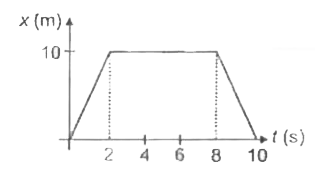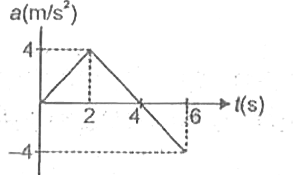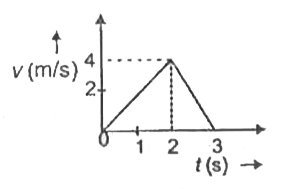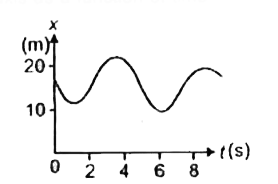Complete Solutions to ASSIGNMENT (SECTION - A) of chapter MOTION IN A STRAIGHT LINE of Class 12 book with complete answers and questions
| Class 12 | PHYSICS |
| Chapter | MOTION IN A STRAIGHT LINE |
| AAKASH INSTITUTE | ASSIGNMENT (SECTION - A) |
| Number Of Questions | 58 |
| Academic Year | 2023-24 |
A body in one dimensional motion has zero speed at an instant. At that instant, it must have
View SolutionA particle is moving along a circle such that it completes one revolution in 40 seconds. In 2 minuts 20 seconds, the ratio `("|displacement|")/("distance")` is distance
View SolutionConsider the motion of the tip of the second hand of a clock. In one minute (R be the length of second hand), its
View SolutionThe position of a body moving along x-axis at time t is given by `x= (t^(2)-4t+6)m`. The velocity of the body at time t = 3s is
View SolutionIf a particle is moving along straight line with increasing speed, then
View SolutionAt any instant, the velocity and acceleration of a particle moving along a straight line are v and a. The speed of the particle is increasing if
View SolutionA particle moves along x-axis with speed `6 m//s` for the first half distance of a journey and the second half distance with a speed `3 m//s`. The average speed in the total journey is
View SolutionIf magnitude of average speed and average velocity over a time interval are same, then
View SolutionIf v is the velocity of a body moving along x-axis, then acceleration of body is
View SolutionIf a body is moving with constant speed, then its acceleration
View SolutionVelocity of a body is variable when
View SolutionAn object is moving with variable speed, then
View SolutionThe position of a particle moving along x-axis is given by `x = 10t - 2t^(2)`. Then the time (t) at which it will momentily come to rest is
View SolutionA car moves with speed `60 km//h` for 1 hour in east direction and with same speed for 30 min in south direction. The displacement of car from initial posilion is
View SolutionA person travels along a straight road for the first `(t)/(3)` time with a speed `v_(1)` and for next `(2t)/(3)` time with a speed `v_(2)`. Then the mean speed v is given by
View SolutionIf the displacement of a particle varies with time as `x = 5t^2+ 7t`.
Then find its velocity.
View SolutionA particle starts moving with acceleration `2 m//s^(2)`. Distance travelled by it in `5^(th)` half second is
View SolutionThe two ends of a train moving with constant acceleration pass a certain point with velocities u and 3u. The velocity with which the middle point of the train passes the same point is
View SolutionThe initial velocity of a particle is u (at t = 0) and the acceleration `f` is given by `f = alphat`. Which of the following relation is valid?
View SolutionThe position of a particle moving along x-axis at time t is given by x = A sin `omega t`, where A and `omega` are positive constant. Select correct option. [Here a = acceleration]
View SolutionA particle moves in a straight line and its position x at time t is given by `x^(2)=2+t`. Its acceleration is given by :-
View SolutionA body is projected vertically upward direction from the surface of earth. If upward direction is taken as positive, then acceleration of body during its upward and downward journey are respectively
View SolutionA particle start moving from rest state along a straight line under the action of a constant force and travel distance x in first 5 seconds. The distance travelled by it in next five seconds will be
View SolutionA body is projected vertically upward with speed 40m/s. The distance travelled by body in the last second of upward journey is [take `g=9.8m/s^(2)` and neglect of air resistance]:-
View SolutionA body is moving with variable acceleartion (a) along a straight line. The average acceleration of body in time interval `t_(1)" to "t_(2)` is :-
View SolutionA body is projected vertically upward with speed `10 m//s` and other at same time with same speed in downward direction from the top of a tower. The magnitude of acceleration of first body w.r.t. second is {take `g = 10 m//s^(2)`}
View SolutionThe position of a particle moving along x-axis given by `x=(-2t^(3)-3t^(2)+5)m`. The acceleration of particle at the instant its velocity becomes zero is
View SolutionA car travelling at a speed of 30 km per hour is brought to rest in 8 metres by applying brakes. If the same car is travelling at 60 km per hour, it can be brought tor est with the same braking force at a distance of
View SolutionA particle is thrown with any velocity vertically upward, the distance travelled by the particle in first second of its decent is
View SolutionA body is thrown vertically upwards and takes 5 seconds to reach maximum height. The distance travelled by the body will be same in :-
View SolutionThe ball is dropped from a bridge ` 122.5 m` above a river, After the ball has been falling for 2 s, a second ball is thrown straight down after it. What must its initial velocity be so that both hit the water at the same time ?
View SolutionA balloon starts rising from ground from rest with an upward acceleration `2m//s^(2)`. Just after 1 s, a stone is dropped from it. The time taken by stone to strike the ground is nearly
View SolutionA boy throws balls into air at regular interval of 2 second. The next ball is thrown when the velocity of first ball is zero. How high do the ball rise above his hand? [Take `g=9.8m//s^(2)`]
View SolutionA ball is projected vertically up such that it passes thorugh a fixed point after a time `t_(1)` and `t_(2)` respectively. Find
a. The height at which the point is located with respect to the point of projeciton
b. The speed of projection of the ball.
c. The velocity the ball at the time of passing through point `P`.
d. (i) The maximum height reached by the balll relative to the point of projection `A` (ii) maximum height reached by the ball relative to point `P` under consideration.
e. The average speed and average velocity of the ball during the motion from `A` to `P` for the time `t_(1)` and `t_(2)` respectively.
 .
.
View SolutionFor a body moving with uniform acceleration along straight line, the variation of its velocity (v) with position (x) is best represented by
View SolutionThe position - time graph for a particle moving along a straight line is shown in figure. The total distance travelled by it in time t = 0 to t = 10 s is

View SolutionThe position - time graph for a body moving along a straight line between O and A is shown in figure. During its motion between O and A, how many time body comes to rest?

View SolutionWhich of the following graph for a body moving along a straight line is possible ?
View SolutionA body is projected vertically upward from ground. If we neglect the effect of air, then which one of the following is the best representation of variation of speed (v) with time (t)?
View SolutionWhich of the following position-time graphs correctly represents two moving objects A and B with zero relative velocity ?
View SolutionThe displacement - time graph for two particles A and B is as follows. The ratio `(v_(A))/(v_(B))` is

View SolutionFor the acceleration - time (a - t) graph shown in figure, the change in velocity of particle from t = 0 to t = 6 s is

View SolutionFigure shows the graph of x - coordinate of a particle moving along x - axis as a function of time. Average velocity during t = 0 to 6 s and instantaneous velocity at t = 3 s respectively, will be

View SolutionPosition - time graph for a particle is shown in figure. Starting from t = 0, at what time t, the average velocity is zer?

View SolutionThe velocity versus time graph of a body moving in a straight line is as shown in the figure below

View SolutionAcceleration - time graph for a particle is given in figure. If it starts motion at t = 0, distance travelled in 3 s will be ,br>

View SolutionFigure shows the position of a particle moving on the x - axis as a function of time

View SolutionA particle moves along x - axis in such a way that its x - co - ordinate varies with time according to the equation `x=4-2t+t^(2)`. The speed of the particle will vary with time as
View SolutionTwo balls are projected upward simultaneously with speeds 40 m/s and 60 m/s. Relative position (x) of second ball w.r.t. first ball at time t = 5 s is [Neglect air resistance].
View SolutionThe position (x) of a particle moving along x - axis veries with time (t) as shown in figure. The average acceleration of particle in time interval t = 0 to t = 8 s is

View SolutionThe position (x) - time (t) graph for a particle moving along a straight line is shown in figure. The average speed of particle in time interval t = 0 to t = 8 s is

View SolutionA ball is dropped from a height h above ground. Neglect the air resistance, its velocity (v) varies with its height (y) above the ground as :-
View SolutionA train of 150 m length is going towards north direction at a speed of 10 m/s. A bird flies at a speed of 5 m/s towards south direction parallel to the railway track. The time taken by the bird to cross the train is equal to
View SolutionTwo cars are moving in the same direction with the same speed `30 km//hr`. They are separated by a distance of `5 km`, the speed of a car moving in the opposite direction of it meets these two cars at an interval of `4` minutes, will be.
View SolutionTwo cars A and B are moving in same direction with velocities 30 m/s and 20 m/s. When car A is at a distance d behind the car B, the driver of the car A applies brakes producing uniform retardation of `2m//s^(2)`. There will be no collision when :-
View SolutionTwo trains each of length 100 m moving parallel towards each other at speed 72km/h and 36km/h respectively. In how much time will they cross each other?
View SolutionA ball is dropped from the top of a building of height 80 m. At same instant another ball is thrown upwards with speed 50 m/s from the bottom of the building. The time at which balls will meet is
View SolutionA particle move with velocity `v_(1)` for time `t_(1) and v_(2)` for time `t_(2)` along a straight line. The magntidue of its average acceleration is
View Solution
ASSIGNMENT (SECTION - A) questions and complete solutions for chapter MOTION IN A STRAIGHT LINE of AAKASH INSTITUTE ENGLISH of Class 12